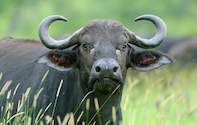
The death of two buffalo from advanced bovine tuberculosis just kilometres from the Kruger National Park's border with Zimbabwe and the death of six lions from the same disease in the last quarter of 2005 were under discussion when the bovine tuberculosis (BTB) study group met on January 16, 2005. The BTB study group consists of Sanparks vets, state vets, scientists from the University of Pretoria and the Onderstepoort Veterinary Institute, Sanparks ecologists and others.
They meet a few times a year to discuss various aspects of the disease, which has been found in many species in the park, including buffalo, lion, leopard, cheetah, hyena, kudu, honey badger, warthog, genets, impala and baboons. Buffalo, lion, warthog and kudu are the animals most commonly found suffering from advanced BTB.
BTB has spread throughout Kruger since it was first discovered in buffalo in 1990 in the south of the park. Finding two animals suffering from advanced BTB near Pafuri indicates that the disease now occurs right up to the far north of Kruger.
To find out the exact extent of BTB in buffalo in the north of the park, the BTB study group is hoping to be able to conduct a survey in the region later in the year. Last year the survey took place in the south of the park. As the central region of the park is continually monitored by an independent research project, the study group believes that a new survey in the north would be most useful in understanding the disease's spread. Previous surveys in 2000 and 2003 showed that less than 10 percent of the buffalo in the northern region and less than two percent in the far north were infected with the disease.
In contrast, one in three buffalo in the south of the park have visible BTB growths in their organs, with more animals testing positive for the disease but not yet showing obvious symptoms. A high proportion of positive buffalo in the south of the park are young animals.
With so many buffalo infected with the disease, it more readily spreads to other species. Lions feasting on infected buffalo can become infected. As the disease progresses, the lions become extremely thin and are often reported to the veterinary authorities. Autopsy of the emaciated lions often reveals BTB.
According to state vet, Dr Roy Bengis, a higher than normal number of these lions is found during the rainy season. He suspects that "the lions take more strain as the prey disperses" with the increased food and water in the veld.
This puts the lions under increased stress and allows the tuberculosis to take its toll. The three female and three male lions found with advanced BTB between September and December were all living south of the Skukuza area, except for one found by the Nwanetsi River Bridge.
Five of the lions were around six years old. One male was estimated to be about three. Dr Bengis remarked that lion cubs can potentially be infected with BTB in their mother's womb or through mother's milk. Bovine tuberculosis has serious implications for the ecology of the park should the disease ever decimate the buffalo or lion population, but it also has human health implications. BTB passes readily between buffalo and cattle, which is how the disease is thought to have entered the park in the beginning.
Should the buffalo pass the BTB back to cattle, a person drinking unpasteurised milk from a TB infected cow can catch the disease, especially if they are immunosuppressed due to a disease like HIV/Aids. It is estimated that about 76,000 communal cattle are found alongside Kruger in South Africa alone, and as fences come down with Mozambique and Zimbabwe in the Great Limpopo Transfrontier Park, the number of potentially infected cattle will certainly increase. To keep an eye on this, cattle are being monitored for the disease on the western boundary of Kruger as time and available manpower permit.
By Melissa Wray

 African Buffalo or Cape Buffalo (Syncerus caffer). A large and powerful bovine, the African Buffalo reaches shoulder heights of up to 1.5 m ...
African Buffalo or Cape Buffalo (Syncerus caffer). A large and powerful bovine, the African Buffalo reaches shoulder heights of up to 1.5 m ...